|
Messerschmitt Bf 109 G-4
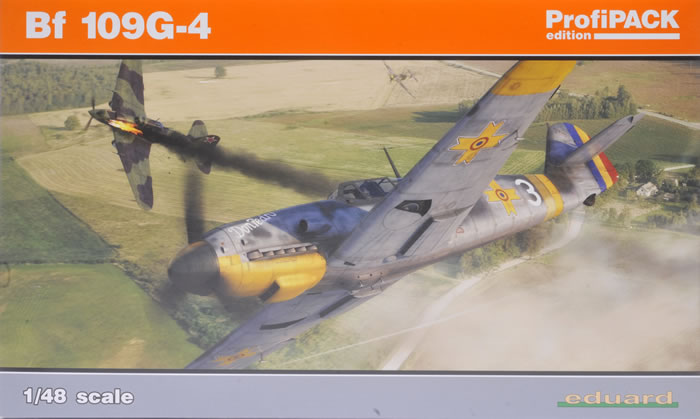
Eduard ProfiPACK, 1/48 scale
S
u m m a r y |
| Catalogue Number: |
Eduard Kit No. 82117 - Messerschmitt Bf 109 G-4 ProfiPACK |
| Scale: |
1/48 |
| Contents and Media: |
187 parts in grey coloured plastic (including 75 marked not for use); 14 parts in clear (nine not used); colour photo-etched fret; self-adhesive die-cut masking sheet; markings for five aircraft |
| Price: |
USD$49.95 plus shipping,
available online now from Eduard
GBP£32.30 (£26.92 Export Price) plus shipping available from Hannants |
| Review Type: |
FirstLook |
| Advantages: |
Accurate; high level of detail; outstanding surface features including crisply recessed panels and subtle rivet lines where appropriate; includes colour photo-etched parts; separate control surfaces; many useful options including alterative propeller blades, wheels, oil cooler housings, bomb racks, trop filter and supercharger intakes (some parts not applicable for this kit); high quality decals; includes die-cut canopy masks. |
| Disadvantages: |
Toothy exhaust stacks. |
| Conclusion: |
This is the first time that Eduard has released a Messerschmitt Bf 109 G-4 as a standalone kit.
Eduard's 1/48 scale Bf 109 G-4 kit is accurate, well detailed and boasts surface textures as good as anything currently available. The addition of coloured photo-etched parts plus an excellent decal sheet with five varied options is also very welcome.
I have already built three of Eduard's 1/48 scale Bf 109 G kits and they were a joy to work on - straightforward engineering, brilliant fit and a gorgeous result once they're finished. I have no reason to expect that this kit will be any different.
Highly Recommended. |
Reviewed by Brett Green

Eduard's 1/48 scale Messerschmitt Bf 109 G-4 ProfiPACK will be available online from Squadron.com
The Bf 109 G-series was developed from the largely identical F-series airframe, although there were detail differences. Modifications included a reinforced wing structure, an internal bullet-proof windscreen, the use of heavier, welded framing for the cockpit transparencies, and additional light-alloy armour for the fuel tank. It was originally intended that the wheel wells would incorporate small doors to cover the outer portion of the wheels when retracted. To incorporate these the outer wheel bays were squared off. Two small inlet scoops for additional cooling of the spark plugs were added on both sides of the forward engine cowlings. A less obvious difference was the omission of the boundary layer bypass outlets, which had been a feature of the F-series, on the upper radiator flaps.
Like most German aircraft produced in World War II, the Bf 109 G-series was designed to adapt to different operational tasks with greater versatility; larger modifications to fulfil a specific mission task, such as long-range reconnaissance or long-range fighter-bomber, were with "Rüststand" and given a "/R" suffix, smaller modifications on the production line or during overhaul, such as equipment changes, were made with kits of pre-packaged parts known as Umrüst-Bausätze, usually contracted to Umbau and given a "/U" suffix. Field kits known as Rüstsätze were also available but those did not change the aircraft designation. Special high-altitude interceptors with GM-1 nitrous oxide injection high-altitude boost and pressurized cockpits were also produced.
The newly fitted Daimler-Benz DB 605A engine was a development of the DB 601E engine utilised by the preceding Bf 109 F-4; displacement and compression ratio were increased as well as other detail improvements to ease large-scale mass production. Takeoff and emergency power of 1,475 PS (1,455 hp, 1,085 kW) was achieved with 1.42 atm (42.5 inches/6.17 lbs) of boost at 2,800 rpm. The DB 605 suffered from reliability problems during the first year of operation, and this output was initially banned by VT-Anw.Nr.2206, forcing Luftwaffe units to limit maximum power output to 1,310 PS (1,292 hp, 964 kW) at 2,600 rpm and 1.3 atm manifold pressure (38.9 inches/4.4 lbs). The full output was not reinstated until 8 June 1943 when Daimler-Benz issued a technical directive. Up to 1944, the G-series was powered by the 1,475 PS Daimler-Benz DB 605 driving a three-blade VDM 9-12087A variable-pitch propeller with a diameter of 3 m (9.8 ft) with even broader blades than used on the F-series. Pitch control, as on the 109F, was either electro-mechanical (automatic) or manual-electric using a thumb-switch on the throttle lever.[61] From 1944 a new high-altitude propeller with broader blades was introduced, designated VDM 9-12159, and was fitted to high-altitude variants with the DB 605AS or D-series engines.
The early versions of the Bf 109G closely resembled the Bf 109 F-4 and carried the same basic armament; however, as the basic airframe was modified to keep pace with different operational requirements, the basically clean design began to change.
Bf 109 G-3 and G-4
In September 1942, the G-4 appeared; this version was identical to the G-2 in all respects, including performance, except for being fitted with the FuG 16 VHF radio set, which provided much clearer radio transmissions and had three-times the range of the earlier HF sets. Externally this could be recognised by the position of the fuselage antenna lead-in which was moved further aft to between frames seven and eight on the fuselage spine.

Due to the steady weight increases of the 109, from the spring of 1943 larger 660 × 160 mm (26 × 6.3 in) mainwheels were introduced, replacing the previously used 650 × 150 mm (25.6 × 6 in) type. The undercarriage legs were altered so that the wheel's vertical axis was nearly upright rather than being parallel with the oleo leg. These changes resulted in the fitting of teardrop-shaped fairings to the upper wing surface above the wheel-wells to accommodate the upper part of the mainwheels. The larger wheels and fairings were often retrofitted to G-2s. In addition, a larger 350 × 135 mm (14 × 5 in) tailwheel replaced the original 290 × 110 mm (11 × 4 in) one; the larger tailwheel no longer fitted the recess, so the retraction mechanism was disconnected and the tailwheel fixed down.
Up to July 1943, 1,242 G-4s were produced, with an additional four in Gy?r and WNF factories in the second half of 1943. Between January and February 1943, 50 examples of a pressurized version, the G-3 were also produced; similar to the G-1 although it was equipped with the same FuG 16 VHF radio set as the G-4.
The following variants of the G-3 and G-4 were produced:
* Historical summary courtesy of Wikipedia
This is the first time that Eduard has released a 1/48 scale Messerschmitt Bf 109 G-4 on its own. Eduard offered a Messerschmitt Bf 109 G-4 option in their 2014 Royal Class Bf 109 G release, but this is the debut release of the standalone kit.
Also note that the 2014 Royal Class kit was the original tooling, whereas this G-4 is based on the new and improved tooling that appeared in 2016.
Eduard's new 1/48 scale Bf 109 G-4 ProfiPACK comprises 187 parts in grey plastic, although there are 75 marked "not for use", bringing the total actually used to 112 (less the options, of which there are quite a few). There are also 14 parts in clear (nine not used), a coloured photo-etched fret, self-adhesive canopy masks and markings for five varied aircraft.
The very attractive box art is also available separately as a Limited Edition EduART poster.
I think that we have seen all of these plastic sprues before in either Eduard's Bf 109 F, G-2 or G-6 kits.
The fuselage is presented as a full-length side per half, including the fin moulded in place, so there should not be any dramas with aligning multiple parts. The upper cowl is moulded to each fuselage half too, with inserts provided for the gun troughs.
In 2013, Eduard’s Spitfire family set a new benchmark for 1/48 scale surface detail, and this new Bf 109 G-4 is equally impressive in this regard. Panel lines are very crisp, fine and even. Lines of rivets are present, but they are very subtle.
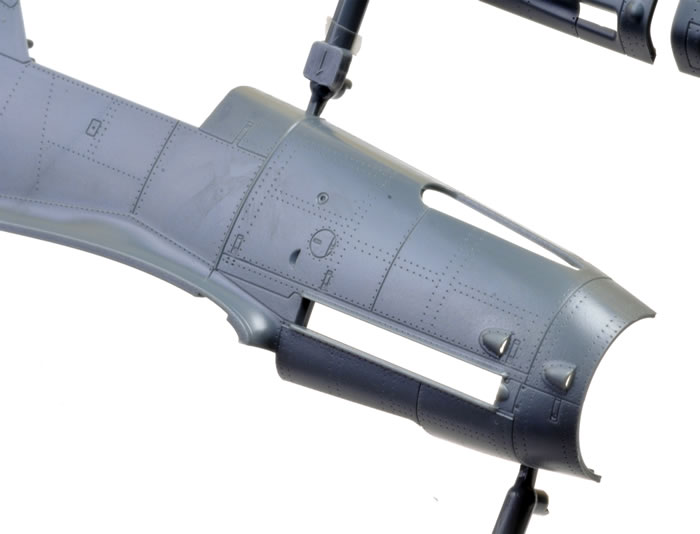
Fabric matches this high standard, with strip and stitching texture beautifully presented on the control surfaces. If you look closely enough, you will even see the zig-zag pinking edges on the fabric strips.
Eduard combines plastic and colour photo-etched parts in their ProfiPACK, resulting in a very high level of detail straight from the box. The cockpit benefits most from the dedicated Bf 109 G-2 coloured photo-etch with a nice multi-layered instrument panel, harness straps and other coloured details. Half-tones and shading seem to have taken a great leap forward on this photo-etched fret, especially the harness straps.
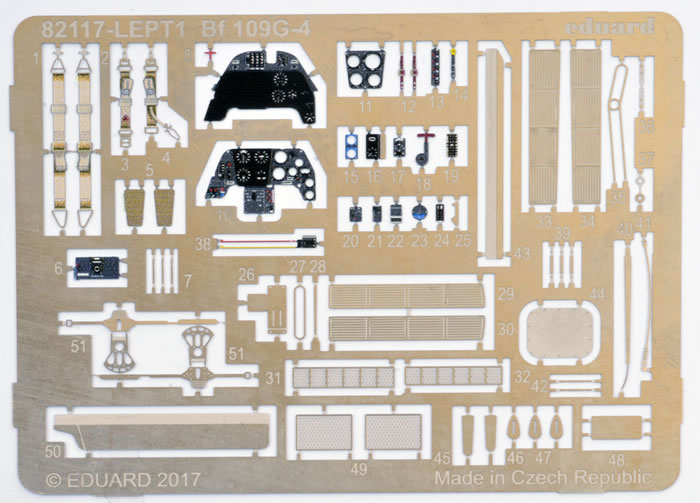
The cockpit is fitted with the pan G-style seat
The canopy is offered in three pieces with the windscreen, fixed rear section and poseable centre. The inclusion of the clear fuel line is a welcome touch. The inspection tube may be masked so that it remains clear after painting.
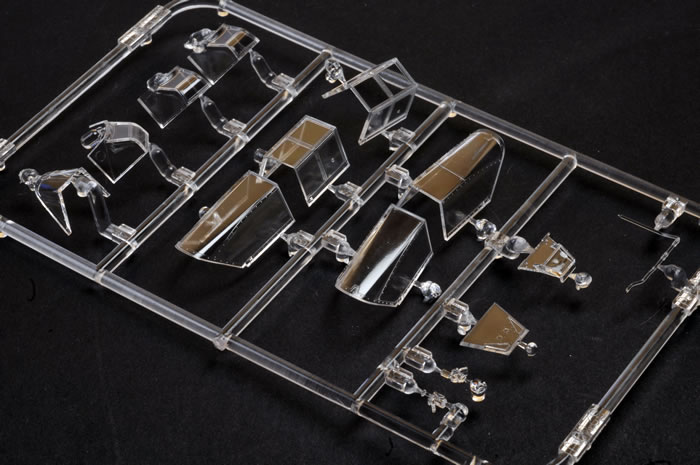
The circular wheel wells are nicely detailed. Eduard depicts the wheel well sidewalls with the zippered canvas covers at the front and rear. The fabric texture looks good, and the zipper is represented by a raised line.
The exhausts are supplied in one piece for each side with an optional moulded-on shroud. The centreline weld beads are present, and each of the stacks are hollowed out at the end.
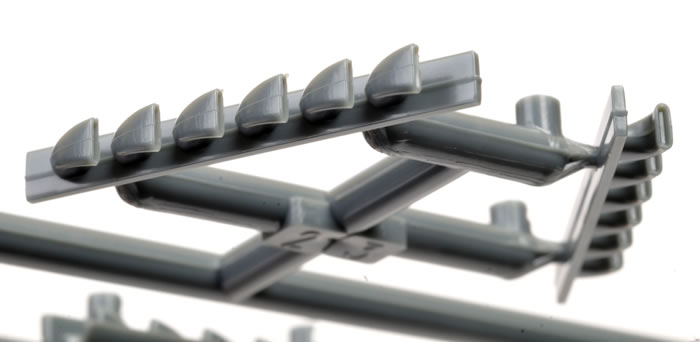
Three propeller assembly options are supplied with nice pitch collar and hub detail, although only the centre version applies to the G-4.
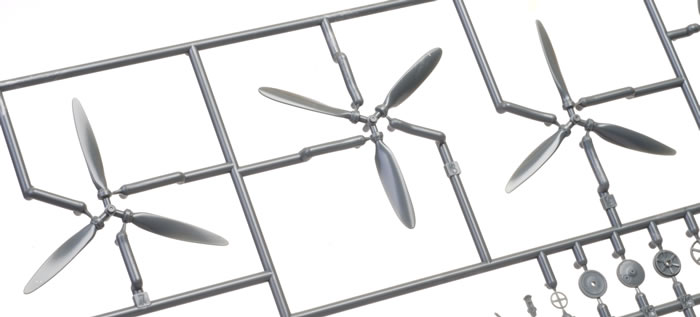
Engineering and Options
The model may be built as a standard G-4, a G-4/Trop, or an G-4/R6 gunboat.
Other options are also available on the sprues although not necessarily mentioned in the instructions.
The kit is broken down conventionally. The fuselage is full-length with no structural inserts. The two deep pressed gun troughs are separate parts.
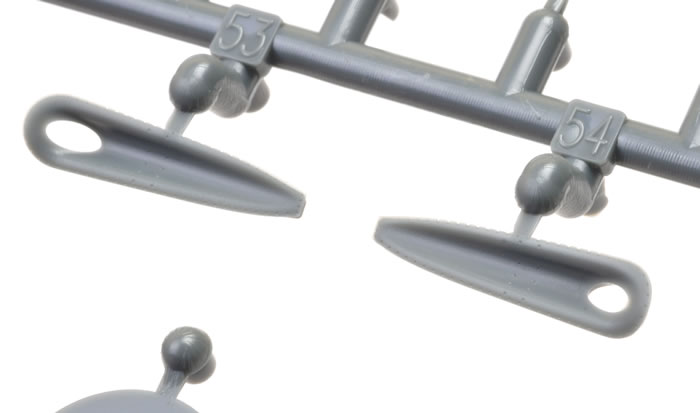
The upper and lower cowls are moulded as part of the fuselage sides.
In this boxing, just one full sets of wings is included (with the wheel bulges on the upper wings).
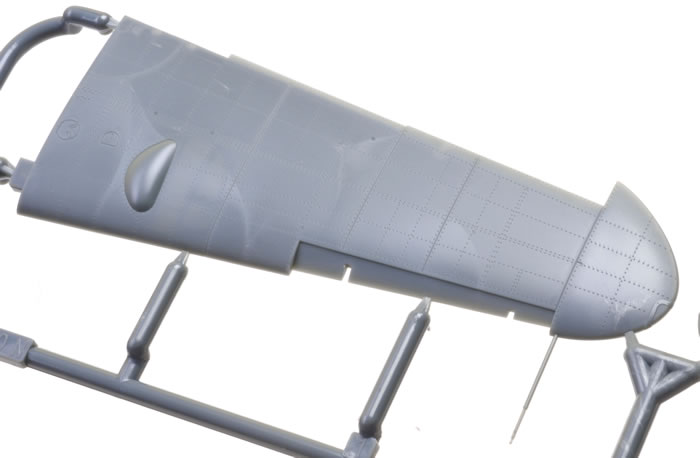
There are a quite a number of options on the sprues that apply to earlier or later versions, so pay attention to the instructions.
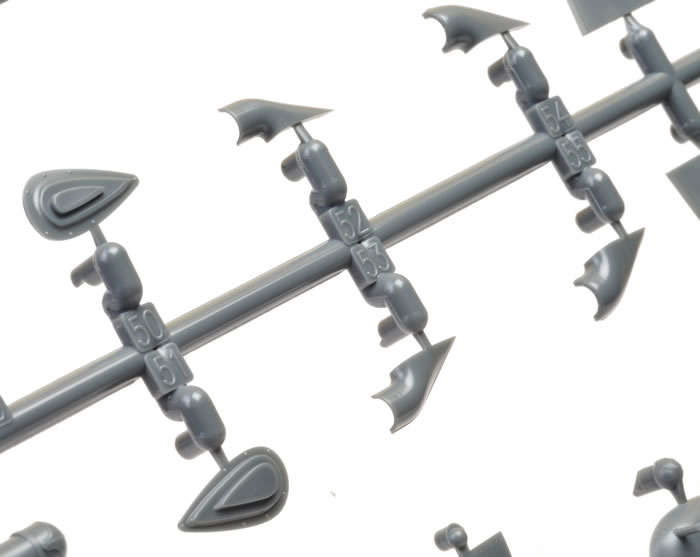
Your spares box will enjoy a boost!
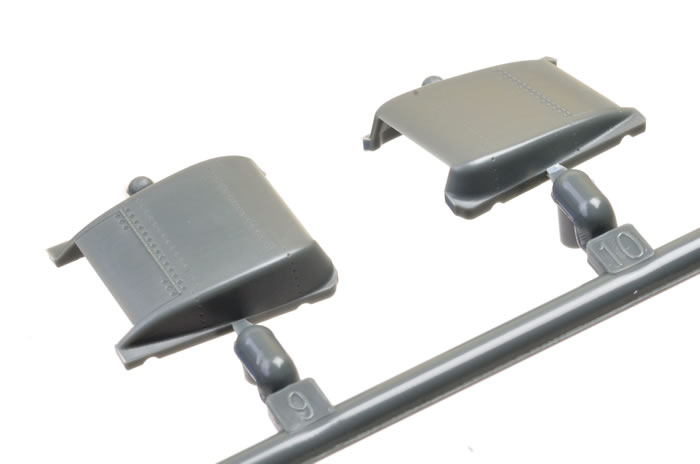
The wing tips are moulded as part of the upper wing halves with solid navigation lights and the pitot tube moulded in place.
All control surfaces are separate, including leading edge slats, ailerons, flaps, elevators and rudder. The ramps at the leading edges of the radiator housings and the cooling flaps at the back of the oil coolers are moulded shut. All the radiator faces are supplied as photo-etched parts.
Many options are offered on the sprues including a drop tank, bombs, bomb racks and different styles of wheel hubs. Some of these relate to earlier and later Bf 109 G or F versions and do not apply, but others – even though they are marked “not for use” – might come in handy for the enterprising modeller.
Check your references to see which of these features is present on your preferred subject – a number of different combinations are possible.
Markings
Markings are supplied for five varied Messerschmitt Bf 109 G-4s:
-
Bf 109 G-4, flown by Lt. Av. P. Protopopescu, Escadrila 57, Grupul 7 Vāna?toare, Kirovograd (Kropyvnytskyi / Ukraine now), Soviet Union, June 1943.
-
Bf 109 G-4/trop, W. Nr. 15013, flown by Lt. U. Seiffert, 8./JG 53, Tindja, Tunisia, April 1943.
-
Bf 109 G-4/R6, W. Nr. 14946, flown by Maj. W. Ewald, Stab III./JG 3, Kertch, Soviet Union, April 1943.
-
Bf 109 G-4/R6, W. Nr. 19566, flown by Ten. G. Gianelli, 365a Squadriglia, 150o Gruppo Autonomo, Sciacca, Sicily, July 1943.
-
Bf 109 G-4/R6, W. Nr. 14997, flown by Lt. E. Hartmann, 7./JG 52, Taman, Soviet Union.
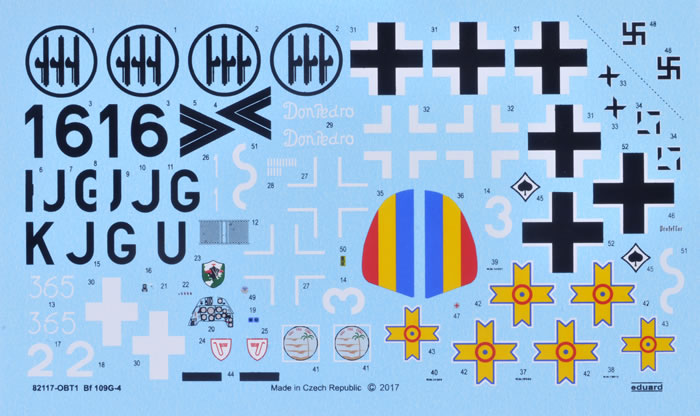
The two decal sheets are perfectly printed in the Czech Republic. One sheet carries the national markings and unique numbers, chevrons, Gruppe markings, unit insignia and kill markings; while the other has a wide selection of generic Bf 109 stencil markings.
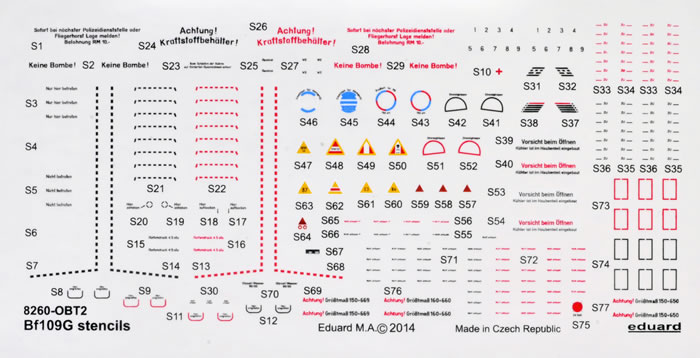
Printing, colours and registration is perfect on my sample.
This is the first time that Eduard has released a 1/48 scale Messerschmitt Bf 109 G-4 as a standalone kit.
The model is accurate, well detailed and boasts surface textures as good as anything currently available. The addition of coloured photo-etched parts plus an excellent decal sheet with six varied options is a real bonus.
I have built three of Eduard's 1/48 scale Bf 109 G kits and they were a joy to work on - straightforward engineering, brilliant fit and a gorgeous result once they're finished. I have no reason to expect that this kit will be any different.
Highly Recommended.
Thanks to Eduard for the sample.
Review Text Copyright © 2017 by
Brett Green
Page Created 28 August, 2017
Last updated
28 August, 2017
Back to HyperScale Main Page
Back to Reviews Page |
